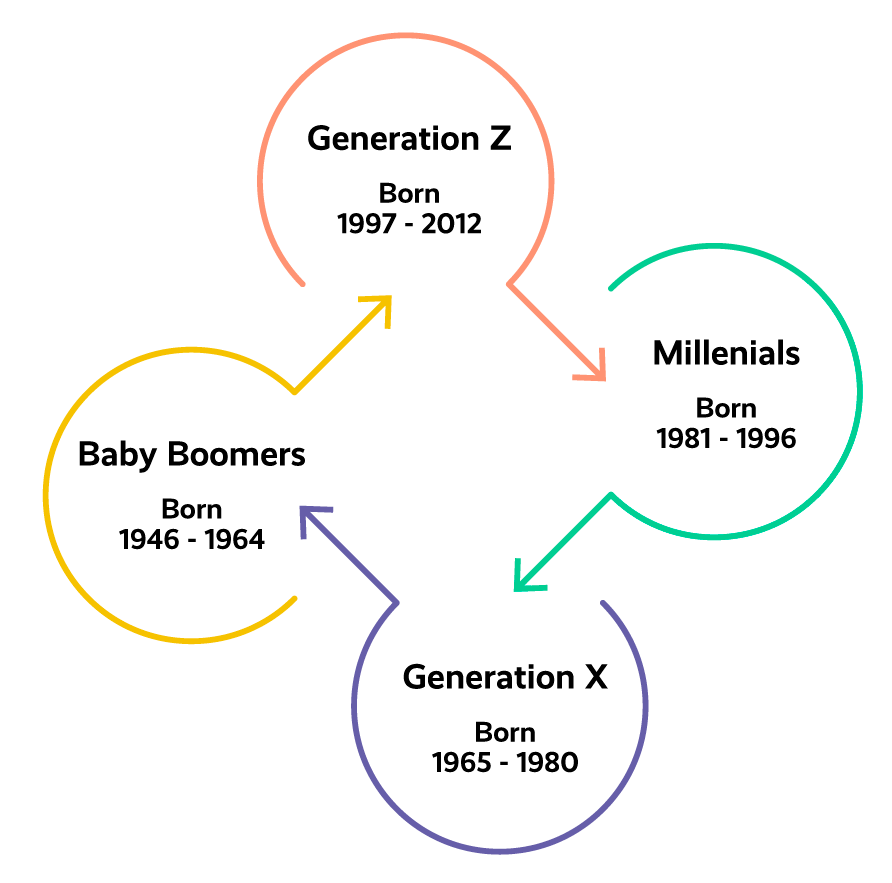The Secret to Training a Multi-Generation Call Center
Leading a contact center workforce with agents whose ages vary widely can be a challenge. You know it, and your agents know it: In its 2020 Global Human Capital Trends report, Deloitte found that only 6 percent of employees surveyed said they felt their leaders were equipped to handle a multi-generational workforce well.
Part of that challenge stems from the fact that different age groups prefer learning styles, and many contact center leaders struggle to accommodate these varying needs. But when you understand the training needs of a multi-generational contact center, you’re better prepared to offer your agents training methods that are most effective for them.
What Are the Generations?
Let’s start by understanding the generations themselves. Pew Media defines the generations as:
Baby Boomers: Born 1946-1964
Generation X: Born 1965-1980
Millennials: Born 1981-1996
Generation Z: Born 1997-2012


Which Generations Are in the Contact Center Workforce?
According to the U.S. Bureau of Labor Statistics data from 2020, more than a quarter (28%) of customer service representatives are ages 25-34 (Millennials). Gen Z (ages 16-24) makes up another 24%, and Gen X and Baby Boomers make up almost half of the contact center workforce.
This diversity in age means there’s no one-size-fits-all contact center training program. In a multi-generational contact center, you have to offer a variety of ways to learn to keep your team engaged and performing well.
To help you choose the best method for training contact center employees, consider the pros and cons of each training method and how it aligns with your generational demographics.
Contact Center Training Method: Role Play
Best with: Baby Boomers
Pros: This generation didn’t grow up in a tech-centered world. They still understand how to connect with people face-to-face, and they enjoy it. Call center role play is an excellent way to give new contact center employees the feeling of actual hands-on experience without throwing them into the lion’s den. We learn much faster by doing and experiencing things ourselves, and role-playing gives employees a chance to practice performing their job duties without the side effects.
TIP: Pair experienced employees, who can role-play as customers, with new employees, who can practice handling different types of calls. This will not only train but create a coaching and feedback session for newcomers.
Cons: While call center role play can give employees an experience very similar to being on the job, scenarios tend to be more simplistic than real calls, and the pressure of dealing with an actual customer is absent. Try using audio or scripts from real calls to give employees a more authentic experience and provide feedback. Gen X is typically more comfortable with self-directed learning and might need some encouragement to participate.
Related Article: 4 Tips for Managing a Multi-Generational Contact Center
Contact Center Training Method: On-the-Job and Shadowing
Best with: Gen X
Pros: Gen X prefers to jump right in and make mistakes as they go. They love to learn independently and thrive on self-directed tools. Providing on-the-job training is undoubtedly an efficient way to give employees real-life experience. It’s low cost and quick. There’s no substitute for the authenticity of on-the-job contact center training, and employees will learn quickly when given the opportunity to take actual customer calls.
Job shadowing in your contact center also gives veteran employees (likely Baby Boomers and some older Gen X agents) a chance to play the expert and teach the newbies. This will make them feel valued while serving the needs of your “now” generations.
Cons: Just because on-the-job training gets new employees working sooner and gives them experience, don’t assume it’s the answer to all your training needs. Throwing new hires into the job too soon can be risky. They can quickly become overwhelmed, and without proper support and guidance, they could develop bad habits.
Be sure that employees have some basic training before throwing them out in the field. If possible, pair new employees with a mentor during the initial stages of their on-the-job training so they can get immediate feedback and have someone to come to their rescue if necessary.
Related Article: Your Complete Guide To Coaching Call Center Agents Into Top Performers

Contact Center Training Method: Online Learning Management System
Best with: Millennials and Gen Z
Pros: Millennials are self-driven like Gen X and highly tech-savvy. Gen Z is even more autonomous. It’s innate to them to access on-demand learning, and they have little patience for long, drawn-out processes. Using an online learning management system (LMS) for your contact center training enables new employees to train at their own pace and availability.
Millennials are focused on self-learning inside and outside their own roles. By using an LMS, you encourage an on-demand learning approach that will keep them engaged and motivated to absorb the information at their own pace.
Additionally, you’ll save time and resources compared to classroom-style learning or job shadowing in the contact center because there’s no need to recreate materials.
Cons: Baby Boomers may struggle with (and resent) the technology. They will likely need more guidance and some training on how to access materials. If you have older employees who are good with tech, use them as role models for other people their age to drive motivation. And don’t completely replace role-playing, job shadowing, and face-to-face training with an LMS — live training in real situations is essential as well.
Keep online learning interesting by using instructional videos or gamification elements to reward and engage staff.
Related Article: Don’t Use Gamification in Your Call Center? Here’s Why You Should
The method you choose for contact center training depends heavily on the predominant demographic of your call center employees. However, if your team reflects the diverse age ranges of most contact centers, try surveying your agents to discover how they like to learn. In most cases, you will find people like a combination of several strategies.
For an even deeper dive into managing a multi-generational contact center team, check out our on-demand webinar, Generational Alphabet Soup: The recipe to support an inter-generational contact center. It’s jam-packed with the tips you need to be an effective leader to a team that spans generations.







